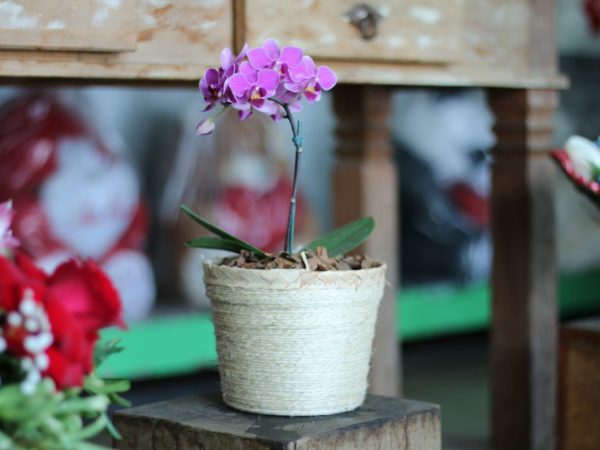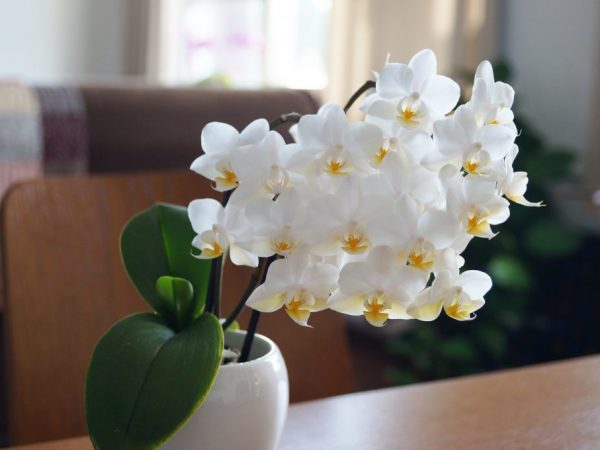Dwarf orchid varieties
Among flower growers, the dwarf orchid, which is distinguished by its small size and some care features, has gained great popularity. Having learned all the subtleties of the content, you can be content with its unusual beauty and a long flowering period.

Dwarf orchid varieties
Features of dwarf species
Dwarf flowers attract attention not only by their small size, but also by their ease of maintenance (compared to ordinary tall species). Placing such indoor plants in your home will not take up much space, and with the right choice of the variety, it will delight a person with a long flowering.
Dwarf flowers vary in size. The average length of the leaves is 15-20 cm. The color and shape of the petals are different. Flowering often occurs in winter, but varieties with two periods of bud formation are also found.
Most of the compact flowers grow on sphagnum moss soil. The presence of tree bark is also allowed. Such plants are demanding on the composition of the substrate and do not like changes. In order for the flower to further delight its owner with its beauty, it is important to provide him with the most comfortable conditions for keeping.
Dwarf plant varieties
Having decided to buy yourself a dwarf exotic plant, you should decide on the best variety for growing in certain conditions. The types of mini orchids are varied:
- Phalaenopsis;
- Cymbidium;
- Cattleya;
- Oncidium.
Each grower independently chooses a suitable flower for himself, both by external features and by other criteria. These species include dozens of varieties that are distinguished by their own decorativeness and demanding care.
Phalaenopsis
A feature of phalaenopsis is the abundance and duration of flowering. It is also important that such flowers rarely enter a dormant period, which is also appreciated by flower growers. The most popular varieties are:
- Orchid Mini Mark. The Mark variety is distinguished by two flowering. The length of the leaves is up to 14 cm, the diameter of the flowers is 4 cm. The petals are white or cream, with pink or orange blotches.
- Dendrobium. This variety is distinguished by an abundance of flowering. Up to 35 flowers appear on the peduncle. The color is white or purple.
- Ludemann's variety. It is distinguished by the disproportionate shape of the petals and sepals. The color is pink-purple, darker at the base of the petals. There are dark blotches on the “lip”. The height of the leaves does not exceed 20 cm, the diameter of the flowering is 5 cm. Up to 7 pieces appear on one peduncle.
- Mini Dog. Has a compact size. The length of the leaves does not exceed 15 cm, the diameter of the flowers is 3-4 cm. The color is white with a pink tint, the "lip" is burgundy, and some petals may have a yellow tint.
When choosing a Phalaenopsis variety, it is important to take into account the peculiarities of their content. Care for such a flower is needed year-round, since it rarely goes into a dormant period.
Cymbidium
If the main goal is to acquire a flower that is undemanding to care for, the best option would be the Cymbidium type. Subspecies of such plants have a pleasant aroma and a beautiful appearance.
The most popular was the aloe-leaf subspecies of the culture. Such a plant will be compactly located on any windowsill. The height of the stem does not exceed 25 cm, and the flowering is 5 cm in diameter. The color of the petals is yellow. Burgundy shades may also prevail.
Cutlley
This species is distinguished by a variety of varieties with buds of different colors (from white to purple). The height of such a plant reaches 20 cm. The most famous varieties are Walker, Atlanda and Skinner.

Plant height is only 20 centimeters
The most popular is the Valkera variety. It is distinguished by the relative proportionality of the height of the stem and the size of the blooms. The average size of the leaves is 10 cm, and the flowers themselves can reach 8 cm in diameter.
Dwarf plant care
Caring for a dwarf orchid differs little from the maintenance of ordinary flowers of medium length. How to care for a mini orchid:
- Schematic watering is required. It is important to consider not only the frequency of the procedure, but also its method.
- Correctly and regularly feed. Use only specialized tools.
- Provide high-quality temperature and humidity levels. Without the necessary microclimate conditions, the plant will quickly die.
It is necessary to monitor the condition of the plant and respond to problems in a timely manner. The appearance of home flowers determines the need to moisturize the soil (wrinkled leaves), as well as save the root system from decay (loss of turgor).
Temperature and humidity
According to climatic characteristics, caring for a dwarf orchid is determined by the age of the plant. The younger it is, the more demanding on air humidity. In order to properly care for a dwarf culture and support its growth and development, it is important that a constant humidity indicator in an apartment is within the range of 50-70%.
Keeping an indoor decorative flower also requires maintaining a certain temperature and lighting at home. Favorable for culture, temperature 21-25 ° C. If the reading is below 15 ° C, the plant sheds its buds and dies. The light in the room should be diffused. Flowers cannot stand direct sunlight.
Watering
The frequency of watering depends on the season. In spring and autumn - once a week, in summer the frequency increases. It is recommended to moisturize the substrate when the substrate is dry.
The type of soil also affects. If a mini orchid is growing in moss, it needs frequent and moderate watering. Plants contained in clay granulates or woody compositions are more water-absorbing, therefore they keep moisture longer.
Watering methods can also vary. Their choice depends on the size of the peduncle. It is allowed to water the plant from a watering can only if its height exceeds 15-20 cm. It is more difficult to work with smaller specimens. Irrigation of the ground part of the plant will be required 1-2 times a day.
Fertilizer
Dwarf orchids need regular feeding throughout the growing season. The frequency of operations is every 2-3 weeks. During the dormant period, flower growers recommend not fertilizing the plant.
Such plants are fertilized both by root and foliar method. The first is only suitable for a dwarf crop grown in a pot with drainage holes. A specialized fertilizer is used. It is necessary to dilute the dressing with water according to the instructions, dip the flower in it for a few minutes, take it out and let the excess moisture drain off.

The flower must be fertilized regularly
The second method of feeding is easier. A non-concentrated fertilizer solution is made (1/4 of the proportion indicated in the instructions), which is used to spray the flower leaves from a spray bottle. It is important to carry out such feeding along with watering the plant.
Dwarf flower transplant
The need to transplant a mini-orchid arises in the first days after buying a plant, especially if it was contained in moss. With the inactivity of the grower, the plant quickly dies, having survived the store bloom. It will only be possible to reanimate it with proper care. The most effective option would be to transplant a mini orchid after purchase into a soil consisting of fractions of tree bark.
When starting a transplant, it is important to decide on the type of new soil, as well as choose a suitable pot. The best soil will be a fine fraction, no more than 1 cm. It will provide them with lightness and the necessary air permeability. The pot for mini orchids should be 1.5-2 times larger than the previous one. Mini orchid varieties do not like to germinate in cramped conditions and will quickly die if the required container sizes are not met. It is also important to pay attention to the following features:
- If you want to transplant a house plant growing in moss, this should be done during the growing season of the plant (in spring). That is, in order to plant a flower on a new soil, you will need to wait for the period of formation of leaves and peduncles.
- Mini orchid varieties tend to have thin, brittle roots that can be easily damaged during transplantation. Therefore, you will have to lower the pot in water so that the soil is saturated with water and separates itself from the root system of the plant.
- An alternative soil for planting is the specialized clay-woody substrate Seramis. In terms of its qualities, it is not inferior to wood material, and thanks to the addition of nitrogen, phosphorus and potassium, it acts as a biostimulant for Orchids.
The planted flower should not fall out of the container (when climbing to the peduncle). It is located on the west side of the dwelling. South windows will not work.
Transplanting a plant into a closed system
Most often, a mini orchid is grown in a specialized pot.
It is a container that does not have drainage holes. This can be ordinary plastic or clay pots for mini orchids, as well as other plastic and glass containers.
It will be possible to plant mini orchids in a closed system, provided that the soil is correctly selected. It is more expedient to use damaged flowers in which the roots need to be saved. The soil must be specialized clay. It is useful to mix it with bark and moss, or arrange them in layers.
Conclusion
There are more than 70 varieties of Orchid, which will delight the grower with their decorativeness and miniature size. Some varieties of indoor plants grow up to 10 cm.
If you follow the rules of caring for mini-orchids at home, the flower will delight its owner with its bright long flowering.


